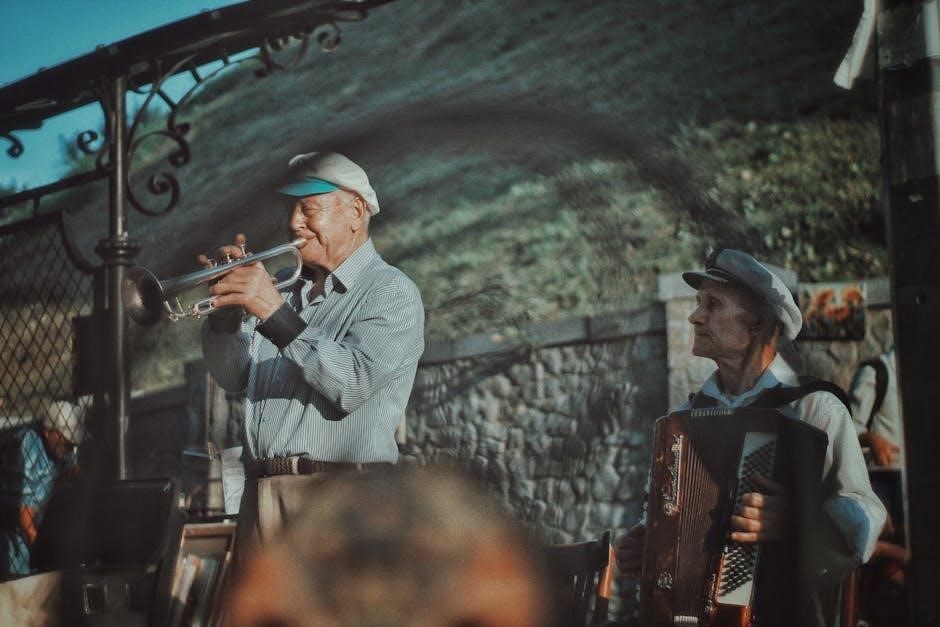A Gentleman’s Guide to Love and Murder is a musical comedy set in 1907 London, following Monty Navarro’s quest to inherit an earldom through murder, love, and ambition.
Overview of the Musical
A Gentleman’s Guide to Love and Murder is a dark comedy musical that masterfully blends wit, murder, and romance. Set in 1907 London, it follows Monty Navarro, a charming but impoverished man who discovers he is ninth in line to an earldom. With a mix of ambition, love, and family drama, the musical showcases intricate murder plots and vibrant characters. Featuring catchy music by Steven Lutvak and Robert L. Freedman, it delivers non-stop laughs and a unique theatrical experience, making it a standout in modern musical theater.
Historical Context and Setting
A Gentleman’s Guide to Love and Murder is set in London during the early 20th century, specifically in 1907. This period reflects the rigid social hierarchy and class distinctions of the time, which play a central role in the story. The musical’s setting is deeply rooted in the Edwardian era, with its opulent aristocracy and strict societal norms. This backdrop provides a rich context for Monty Navarro’s journey, highlighting themes of ambition, lineage, and the clash between old-money privilege and rising middle-class aspirations.
Plot and Characters
A Gentleman’s Guide to Love and Murder follows Monty Navarro, a penniless clerk, as he navigates a murderous quest to inherit an earldom, juggling love and family ties.
The Story of Monty Navarro
Monty Navarro, a penniless clerk, discovers he is ninth in line to the Earldom of Highhurst after his mother’s death. Driven by ambition and revenge, Monty embarks on a murderous spree to eliminate the heirs above him. His journey is a darkly comedic exploration of love, family, and class, as he navigates his dual life as a charming gentleman and a calculating killer. The story showcases Monty’s wit, charm, and moral dilemmas, blending humor with the absurdity of his lethal ambitions.
Key Characters and Their Roles
Monty Navarro is the charming but penniless protagonist who discovers his distant lineage to the Earldom of Highhurst. The D’Ysquith family, led by the arrogant Lord Adalbert, stands in his way. Sibella Hallward, a vain gold-digger, and Phoebe D’Ysquith, Monty’s virtuous cousin, represent his conflicting love interests. The role of the entire D’Ysquith clan is memorably played by a single actor, showcasing comedic brilliance. These characters drive the story’s dark humor, ambition, and intricate relationships.
The Inheritance and the Line of Succession
The inheritance plot revolves around Monty Navarro, a penniless clerk who discovers he is ninth in line to the Earldom of Highhurst. Upon learning of his distant lineage, Monty devises a murderous scheme to eliminate the eight relatives ahead of him. The D’Ysquith family, known for their aristocratic arrogance, unknowingly stands in his way. This dark comedy explores the complexities of succession, as Monty’s ambition drives him to commit a series of clever, calculated murders, blending humor with the suspense of his precarious plan.

Music and Lyrics
A Gentleman’s Guide to Love and Murder features music by Steven Lutvak and lyrics by Lutvak and Robert L. Freedman, blending witty humor with lively, imaginative tunes.
Steven Lutvak and Robert L. Freedman’s Collaboration
Steven Lutvak and Robert L. Freedman’s partnership brought A Gentleman’s Guide to Love and Murder to life. Lutvak composed the music, while Freedman wrote the book and co-wrote the lyrics, blending witty dialogue with catchy melodies. Their collaboration seamlessly integrated music and storytelling, creating a unique comedic tone. The duo’s work earned widespread acclaim, including a Tony Award for Best Musical, showcasing their innovative approach to musical theater. Their partnership encapsulates the show’s dark humor and charming elegance, making it a standout production.
Notable Songs and Their Significance
The musical features a range of memorable songs that highlight its themes of ambition, love, and murder. Tracks like “You’re Never Too Old to Die Young” and “I Don’t Understand the Poor” showcase the wit and dark humor of the story. These songs not only advance the plot but also delve into the complexities of Monty’s character and the societal commentary on class. The music seamlessly blends with the narrative, making the songs integral to the show’s charm and comedic brilliance, while also reflecting the characters’ emotional journeys and moral dilemmas.
Musical Style and Genre
A Gentleman’s Guide to Love and Murder blends witty dialogue, dark humor, and clever music, falling under the genre of musical comedy. The score, crafted by Steven Lutvak and Robert L. Freedman, combines classical operetta influences with modern musical theater sensibilities. Set in 1907 London, the music evokes the elegance of the era while maintaining a contemporary appeal. The orchestration, featuring brass, strings, and woodwinds, supports the show’s lighthearted yet murderous tone, creating a unique balance of comedy and sophistication that defines its style and captivates audiences.

Production and Staging
A Gentleman’s Guide to Love and Murder features elaborate set designs, period-specific costumes, and innovative staging that bring 1907 London to life, blending dark humor with visual elegance.
Original Broadway Production Details
A Gentleman’s Guide to Love and Murder opened on Broadway at the Walter Kerr Theatre on November 17, 2013, and closed on January 17, 2016. Directed by Darko Tresnjak, the production starred Jefferson Mays, who famously played all eight members of the D’Ysquith family. The show ran for 908 performances, earning widespread acclaim for its dark humor, intricate set design, and period-specific costumes. Its innovative staging and Mays’ virtuosic performance became hallmarks of the production, solidifying its place as a Broadway standout in the 2014 season.
Costume and Set Design
A Gentleman’s Guide to Love and Murder features intricate costume and set design that immerses audiences in 1907 London. The opulent Victorian-era costumes, designed by Linda Cho, reflect the characters’ social status, with vibrant colors and detailed patterns. The set, crafted by Alexander Dodge, includes a rotating centerpiece and cleverly transforming elements that enhance the show’s dark humor and ambitious plot. These designs earned critical acclaim, blending period authenticity with theatrical ingenuity to create a visually stunning experience that complements the story’s witty and murderous charm.
Unique Aspects of the Stage Adaptation
A Gentleman’s Guide to Love and Murder stands out for its innovative storytelling and comedic brilliance. The stage adaptation cleverly uses a single actor to portray multiple members of the D’Ysquith family, showcasing versatility and wit. The production’s dark humor, paired with its lighthearted musical score, creates a unique tone that captivates audiences. The adaptation’s ability to balance intricate murder plots with non-stop laughs and imaginative staging makes it a standout in modern musical theater, offering a fresh and entertaining take on ambition and morality.
Awards and Recognition
A Gentleman’s Guide to Love and Murder won four Tony Awards, including Best Musical, with Jefferson Mays and Lauren Worsham earning notable recognition, and received ten nominations in 2014.
Tony Awards and Nominations
A Gentleman’s Guide to Love and Murder triumphed at the 2014 Tony Awards, winning four awards, including Best Musical. Jefferson Mays earned Best Actor in a Musical for his dazzling portrayal of multiple roles, while Lauren Worsham won Best Featured Actress. The musical received ten nominations, showcasing its excellence in book, direction, and design. This recognition solidified its place as one of the standout productions of the season, celebrating its innovative storytelling and performances.
Other Notable Awards and Accolades
A Gentleman’s Guide to Love and Murder earned widespread acclaim beyond the Tony Awards. It won four Drama Desk Awards, including Outstanding Musical and Outstanding Actor for Jefferson Mays. The musical also received recognition from the Outer Critics Circle, securing awards for Outstanding Musical and Outstanding Actor in a Musical. Its innovative storytelling and stellar performances were praised by critics, further cementing its reputation as a standout production in musical theater during the 2014 season.

Impact on Musical Theater
A Gentleman’s Guide to Love and Murder left a lasting imprint on musical theater, showcasing the power of dark comedy and intricate storytelling. Its success paved the way for innovative, genre-blending productions and highlighted the potential of lesser-known historical inspirations. The show’s critical acclaim and commercial success demonstrated the audience’s appetite for clever, morally ambiguous narratives and inspired future creators to explore similar themes. Its legacy endures as a landmark production in modern musical theater history.
Themes and Messages
A Gentleman’s Guide to Love and Murder explores themes of ambition, love, family dynamics, morality, and social class, using dark humor and intricate plots to highlight human complexity.
Ambition, Love, and Family Dynamics
A Gentleman’s Guide to Love and Murder delves into the complexities of ambition, love, and family ties. Monty Navarro’s journey from penniless clerk to potential earl highlights the clash between upward mobility and moral integrity. His pursuit of love, torn between the cunning Sibella and the naive Phoebe, underscores the societal pressures of romance. Family dynamics are further explored through the D’Ysquith lineage, revealing the dark humor in inheritance and murder, while questioning the true cost of ambition and the blurred lines between love and manipulation.
Morality and the Consequences of Actions
A Gentleman’s Guide to Love and Murder explores the moral ambiguity of Monty Navarro’s actions, blending dark humor with ethical dilemmas. While Monty’s murderous schemes are morally questionable, his charm and relatability evoke empathy, challenging audiences to question right and wrong. The musical highlights the consequences of unchecked ambition, where Monty’s pursuit of wealth and status leads to a tangled web of deceit and murder. This moral complexity adds depth to the comedy, inviting reflection on the nature of justice and redemption.
Social Class and Hierarchy
A Gentleman’s Guide to Love and Murder satirizes the rigid social class system of early 20th-century Britain. Monty Navarro’s journey from poverty to aristocracy critiques the hierarchy and privilege of the upper class. The D’Ysquith family represents the entitled elite, while Monty’s lower-class origins fuel his ambition. The musical humorously examines the moral compromises one makes to climb the social ladder, offering a witty commentary on class mobility and the absurdities of societal expectations.
Reception and Reviews
A Gentleman’s Guide to Love and Murder received widespread critical acclaim for its witty humor, memorable music, and standout performances, including multiple Tony nominations and wins.
Critical Acclaim and Audience Response
A Gentleman’s Guide to Love and Murder garnered widespread critical acclaim for its dark comedy, clever plot twists, and exceptional performances. Audiences praised its witty humor, memorable music, and the standout role of Monty Navarro, which showcased the actor’s versatility. Critics highlighted the show’s originality and imaginative storytelling, with many applauding its ability to balance murder, love, and family dynamics with comedic brilliance. The musical became a favorite among theatergoers, earning a reputation as a hilarious and engaging production.

Comparisons to Other Musicals
A Gentleman’s Guide to Love and Murder is often likened to classic musical comedies like The Book of Mormon and The Producers for its dark humor and witty storytelling. Its unique blend of murder, romance, and family drama sets it apart, earning comparisons to both contemporary and timeless theatrical works. The show’s intricate plot and comedic brilliance have drawn parallels to plays like Kind Hearts and Coronets, further solidifying its place as a standout in modern musical theater.
Longevity and Revivals
A Gentleman’s Guide to Love and Murder has proven its lasting appeal through successful revivals and productions worldwide. Its unique blend of dark comedy, intricate plot, and memorable music continues to attract audiences. The musical’s original Broadway run from 2013 to 2016 showcased its staying power, and regional theaters have embraced it for its adaptability and audience engagement. Its enduring popularity highlights its timeless themes of ambition and love, ensuring its place in theatrical repertoire for years to come.




